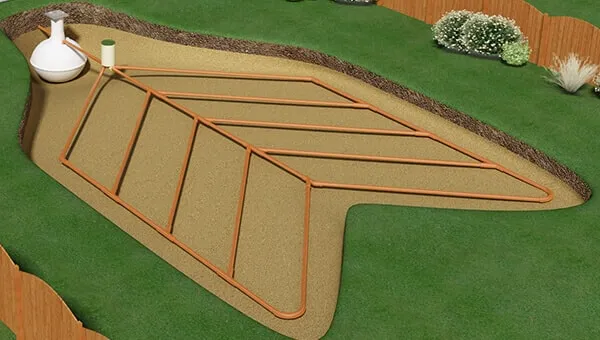Everything You Need to Know About Drainage Fields

Has your toilet been flushing slowly lately? Or maybe you've noticed wet spots in your yard with strange odors? These could be signs of problems with your drainage field.
Many homeowners don't think about what happens after they flush until something goes wrong!
We understand how confusing and frustrating septic system problems can be. The good news is that with the right knowledge, you can keep your drainage field working properly for many years.
In this friendly guide, we'll walk you through everything you need to know about these important systems in simple, easy-to-follow steps.
What Is a Drainage Field?
Basic Function and Purpose
A drainage field is a key part of your septic system that helps clean wastewater.
It works like this:
Wastewater leaves your house and flows into the septic tank
Solid waste settles in the tank
Liquid waste flows out into the drainage field
The liquid filters through soil and gravel, which removes harmful bacteria
According to the Environmental Protection Agency (EPA), a properly working drainage field is essential for protecting groundwater and keeping your property clean.
Components of a Drainage Field
Your drainage field consists of several important parts:
Distribution box that divides wastewater evenly
Perforated pipes that release water into the soil
Gravel beds that support pipes and help with filtration
Special soil that filters out contaminants
Bacteria that break down remaining waste
The National Onsite Wastewater Recycling Association explains that all these components must work together for effective wastewater treatment.
Other Names for Drainage Fields
You might hear people call your drainage field by different names:
Septic drain field
Septic tank drain field
Leach field
Soil absorption system
Percolation field
All these terms mean the same thing - the area where wastewater from your septic tank filters into the soil.
Signs of Drainage Field Problems
Warning Signs to Watch For
Spot problems early by looking for these warning signs:
Wet, mushy areas in your yard
Bad smells around your yard
Slow-draining sinks and toilets
Bright green grass over your septic drain field
Sewage backing up into your home
Gurgling sounds in your plumbing
The National Environmental Services Center reports that catching problems early can save you thousands in repair costs.
When to Call a Professional
Call a septic system professional immediately if you notice:
Standing water over your septic tank drain field
Sewage smells inside your home
Multiple slow drains throughout your house
Sewage backing up into toilets or sinks
Lush, green patches over your drainage field during dry weather
Don't wait! The Centers for Disease Control (CDC) warns that failed septic systems can pose serious health risks to your family.
How to Maintain Your Drainage Field
Daily Habits to Protect Your System
Follow these simple rules every day:
Don't park vehicles on your drainage field
Keep trees and large plants away from the area
Direct roof and surface water away from your septic drain field
Use water efficiently in your home
Don't flush anything but toilet paper
Use septic-safe cleaning products
Fix leaky faucets and toilets promptly
According to Consumer Reports, these habits can double the life of your septic system.
Regular Maintenance Tasks
Schedule these maintenance tasks:
Have your septic tank pumped every 3-5 years
Inspect your septic tank drain field yearly for signs of problems
Keep records of all maintenance and pumping
Test your soil and groundwater periodically
Have distribution box checked for even flow
Inspect baffles and filters in your septic tank
The National Association of Home Builders recommends creating a maintenance calendar for these important tasks.
How to Protect Your Drainage Field
Things to Avoid
Keep these things away from your drainage field:
Chemicals and cleaning products that kill beneficial bacteria
Grease and oil from cooking
Paint and paint thinners
Heavy equipment and vehicles
Livestock
Deep-rooted trees and shrubs
Garbage disposals (use sparingly if you have one)
Hot tubs that drain into your septic system
Michigan State University Extension reports that even small amounts of certain chemicals can damage your system.
Best Practices for Long-Term Care
Follow these best practices:
Use septic-safe toilet paper
Install water-efficient fixtures to reduce load
Spread out laundry loads throughout the week
Keep accurate records of your system's location and maintenance
Don't build structures over your septic drain field
Add risers and lids to make future maintenance easier
Consider using septic additives approved by your local health department
The Water Environment Federation recommends these practices for extending your system's life by decades.
Installing a New Drainage Field
Site Selection Requirements
Choose your site carefully by considering:
Distance from wells, streams, and property lines
Soil type and absorption capacity
Depth to groundwater or bedrock
Size of your home and water usage
Local building codes and permits
Slope of the land
Future expansion needs
The University of Minnesota Extension recommends getting a professional soil evaluation before installation.
Installation Steps
Follow these steps when installing a new drainage field:
Obtain necessary permits from your local health department
Hire a licensed installer with good references
Prepare the site by removing topsoil
Install drain pipes in gravel-filled trenches
Cover pipes with approved filter fabric
Add final soil cover and grass seed
Document the installation with photos and detailed measurements
Get final approval from your local inspector
According to This Old House, proper installation is critical for preventing future problems.
Conclusion
Understanding your drainage field is an important part of being a responsible homeowner. By following the maintenance tips and warning signs we've shared, you can protect your investment and avoid costly repairs.
Remember that prevention is always easier than fixing a failed system. Regular care of your septic system will save you money and headaches in the long run. We hope this guide has given you the tools you need to properly maintain your drainage field for years to come!

© 2025 | All Rights Reserved | Privacy Policy
